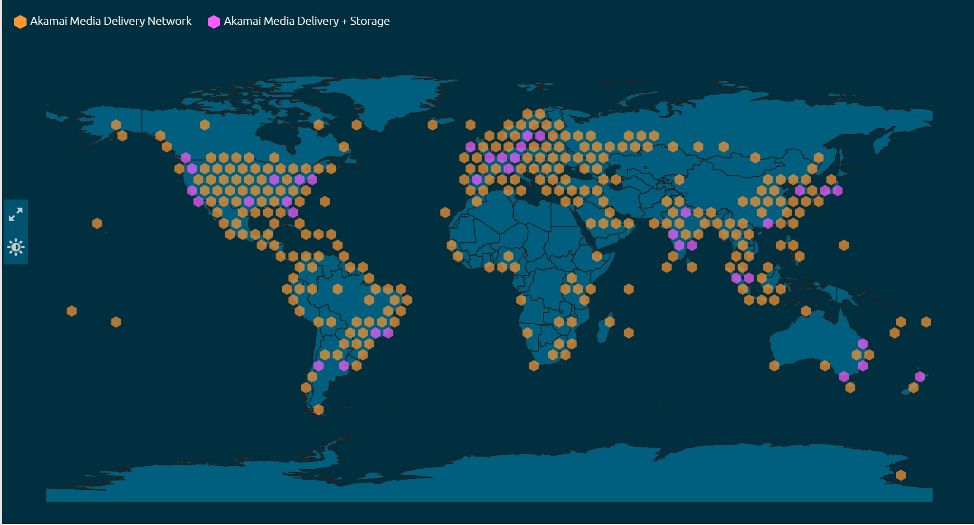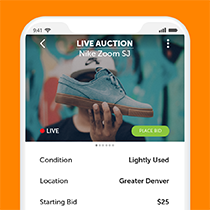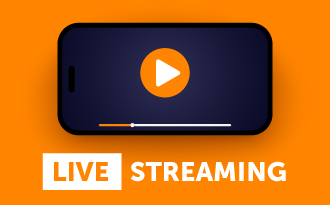6 Best CDNs for Live Streaming
February 24, 2020
Anyone streaming a live event to more than a few dozen viewers should consider distributing the video through a content delivery network (CDN). In this article, I’ll describe what a CDN is, tell you why you need one, and identify the factors to consider when choosing a CDN for live streaming. At the end, I’ll present a list of the top six CDNs to consider for live streaming.
We’ll take a detailed look at the following top-ranking providers:
What Is a CDN?
A content delivery network is a distributed network of servers designed to efficiently deliver web-based content to a geographically dispersed group of video consumers. Assuming that you were producing an event for a local church or high school and served all of your videos from a web server in Kansas City, MO, most streams would be distributed within a few miles of the origination point.
On the other hand, suppose many of your streams were delivered to viewers in New York or California — or even Europe and Australia. The packets that convey these videos would have to travel over multiple “hops” as they switched from router to router, which would slow down delivery and increases the risk of packet loss. If the video began to spike in popularity, viewer requests could overwhelm the origin server — degrading delivery to all.
Why Do You Need a CDN for Live Streaming?
CDNs overcome these delivery challenges by using caching servers closer to viewers. To continue with the above analogy, if you hired a CDN to deliver your Kansas City-based live event, you would deliver the video from your encoder to a nearby server hosted by the CDN for ingest. For an end-user watching the event from New York, the CDN would deliver the packets to a local server via dedicated high-bandwidth internal connections, avoiding the multiple hops. Once the packets arrived safely in New York, the CDN could easily distribute the content to other nearby viewers. Since the origin server would only need to deliver the packets to a limited number of CDN caching servers, it would never get overwhelmed by too many connections.
The bottom line is that if you’re attempting to deliver a premium experience to a large, geographically diverse set of viewers, you should strongly consider a CDN.
What to Look For in a CDN
Here are the features and factors to consider when evaluating the candidates. When you start your research, understand that many CDNs offer multiple media-related services, including many of the transcoding and packaging functions that you use the Wowza Streaming Engine or Wowza Video to perform. For that reason, this list focuses solely on media delivery, not transcoding or packaging.
1. Does The CDN Support Live Streaming?
This question is twofold. First, does the service actually offer live streaming delivery? Second (and equally important), does the CDN adequately support live streaming so you can easily implement and support your live events?
The best places to look are the technical documentation offered by the CDN and that of your streaming server/transcoding engine, which I’ll assume is either Wowza Streaming Engine or Wowza Streaming Cloud. If either the CDN or Wowza has documented how the systems work together, that means you’re not a trailblazer and that there are resources that can help you get and stay connected. If not, a lower cost per GB might not be worth the hassle.
You should also ascertain the cost of live support and the hours of operation. All live events are mission-critical, and you should prioritize timely access to technical support above almost all other factors.
2. Does the Service Support Your Adaptive Bitrate (ABR) Format?
Not all services that support live streaming can handle all relevant ABR protocols; some only handle HTTP Live Streaming (HLS). If you’re streaming MPEG-DASH to smart TVs and perhaps Smooth Streaming to Xboxes, make sure your candidate CDNs support these requirements.
3. Where Are You Storing Your Content?
Amazon, Azure, and Google all offer CDN functionality. If you’re storing your files on any of these cloud platforms, it’s probably cheaper and simpler to use their CDN services, particularly if you distribute both VOD and live video.
4. Where Do You Run Your Streaming Server?
Again, assuming that you’re using Wowza Streaming Engine, you can run it from any of the three cloud platforms mentioned above (Amazon, Azure, and Google). If this is the case, ingress into the cloud platform’s CDN will be more efficient than any other. It may also be simpler and less expensive.
5. What Geographical Coverage Do You Need?
For most efficient operation, the CDN would have an ingest point proximate to the location of your streaming server/transcoding engine and points of presence (PoPs) close to the location of your viewers. This shouldn’t be a problem with most CDNs if you’re originating and delivering within the U.S. — but overseas access varies significantly, particularly for China and Russia.
6. Pricing
Not all CDNs publish their prices online, which can be frustrating. Most that do publish pricing provide the cost per-GB of video transferred, which ranges from $0.04 per GB to $0.12/GB (all quoted prices are U.S. prices, and worldwide prices vary significantly).
For perspective, if you stream an hour of video at about 2.2 Mbps, you’ll consume about a GB an hour. So, if you have 10,000 viewers for an hour-long event, and are paying the top price of $0.12/GB, your bandwidth bill will come to about $1,200.
Delivery pricing should be the largest component of your total streaming costs — but check for internal data transfer charges, charges for HTTP and HTTPS requests, and similar items.
Our Top 6 CDNs for Live Streaming
With this as background, here are the CDNs I would consider. To compile this list, I spent a day perusing the websites of multiple CDNs using the factors described above to identify the service providers that I would place on my shortlist if making a CDN selection.
To be clear to readers (and CDNs not mentioned) as to my procedure, I checked a number of factors to decide which CDNs to include, specifically:
- Do they mention video delivery as a separate service?
- Did they provide documentation on how to connect a live stream to their CDN?
- When I searched for Wowza, HLS, or DASH on their site or support documentation, did any articles appear?
- Did Wowza have any documentation relating to that CDN?
If the answer was no for most or all of the above, I excluded that service provider. Here are the ones that made the cut.
1. Fastly
Fastly’s Video CDN can deliver HLS, MSS (Microsoft Smooth Streaming), HDS, and DASH and has excellent documentation for integrating with a range of encoders, including Wowza Streaming Cloud. Fastly offers a distributed network of over 60 PoPs in 30 countries and offers multiple support plans, some of which include 24/7 phone, email, and Slack support.
Transfer charges start at $0.12 and drop to $0.08 after the first 10 GB, but that’s the lowest pricing published by the site. You can access the Fastly CDN via the Wowza CDN for Wowza Streaming Cloud. The cost per GB starts at $0.095 and drops to $0.049 at high volumes. Some plans include a fixed amount of CDN usage in their monthly fee, so additional charges are incurred only when the included usage has been consumed. You can read about the features offered through the Wowza CDN on Fastly here. Wowza has additional documentation available here.
Fastly is also partnering with Wowza to deliver advanced stream analytics, including near real-time visibility into bandwidth consumption, the number of viewers, and regional metrics. More information about this integration is available in this blog post.
2. Akamai
Akamai is one of the largest CDNs in operation, if not the largest, and the service can ingest and deliver HLS, HDS, and DASH live streams from the Wowza Streaming Engine as documented here. With servers located in over 130 countries and extensive coverage in the United States, accessing servers close to your ingest point and customers shouldn’t be a problem. Akamai offers 24/7 technical support by phone and email.

3. KeyCDN
KeyCDN appears to deliver HLS only via its network of 34 PoPs in 23 countries. Documentation is sparse but should be sufficient to get you up and running. The only support option shown on the site is logging in and sending a support request, but it’s possible that more options are available. The primary attraction of KeyCDN is pricing, which starts at $0.04/GB and drops to $0.01/GB at reasonable volumes.
4. Microsoft Azure
Microsoft Azure is a full-service cloud platform with storage, Wowza hosting, and delivery. For live streaming, Azure can ingest HLS, DASH, HDS, and MSS. Azure can deliver through its own CDN or via Akamai and Verizon Media. The Azure CDN from Microsoft has 129 PoPs in over 65 metropolitan areas located in over 50 countries, with complete details about the coverage of the three CDNs here.
In North America, Microsoft offers support from 6:00 a.m. to 6:00 p.m. (Pacific Time), Monday through Friday, excluding holidays. Support in other regions conforms to typical business hours in those locations.
Azure offers two pricing tiers. Standard pricing available through all three CDNs starts at $0.081 and drops to $0.023 at very high volumes. Premium service available only through Verizon starts at $0.158 and drops to $0.084, which includes a premium rules engine and advanced analytics, stats, and reporting. You can read about the features available through the various CDNs and plans here.
5. Amazon Cloudfront
Amazon Cloudfront is another full-service cloud platform with storage, Wowza hosting, and delivery of HLS, DASH, HDS, and MSS streams. The Cloudfront CDN has 216 PoPs in 42 countries. Amazon offers multiple support plans, including several with 24/7 phone, email, and chat access to cloud support engineers. Cloudfront pricing starts at $0.085 and drops down to $0.02/GB. Wowza’s documentation is available here.
6. Limelight Networks
Limelight Networks has over 130 PoPs in 70 countries, providing a good base for worldwide delivery. Wowza details how to connect to the Limelight CDN here (Limelight’s support documentation isn’t publicly available). The connection technique is both less functional and more complicated than with most CDNs, so check this out first if you’re considering Limelight. Limelight offers free unrestricted 24/7 live customer support by phone or email but doesn’t publish pricing.
CDNs in Other Regions
Beyond the CDNs listed above, there are some other CDNs I would consider for specific regions, like CDNvideo for Russia, Alibaba for China, and GS Neotek for South Korea and Asia.





